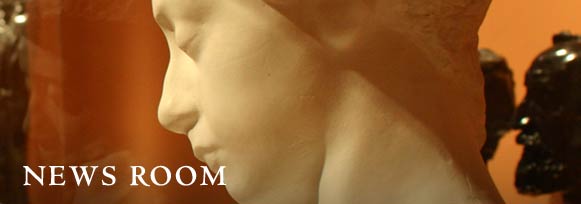Collection Highlights from Europe, Ancient Greece and Rome Opens May 5, 2010
Collection Highlights from Europe 1500–1800, Ancient Greece and Rome
Opens May 5, 2010
Stanford, California --- Cantor Arts Center at Stanford University announces the opening on May 5, 2010 of “Collection Highlights from Europe 1500-1800, Ancient Greece and Rome,” which continues indefinitely. The museum’s second-floor gallery devoted to European art is revitalized and now includes artworks from the ancient Mediterranean, in addition to 16th- through 18th-century art from western Europe. Divided into six sections, the gallery presents highlights from the collection as well as significant loans from private collections. Admission to the museum and the exhibition is free.
Visitors can again see important works from the Center’s collection of Greek, Roman, and Cypriote artifacts, which have been off view since February 2009. This new display of ancient art offers students and the public a wide variety of objects to study and enjoy, including portrait reliefs from Palmyra, clusters of red- and black-figure Grecian vases, marble torsos from Rome, as well as diverse Cypriote vessels.
The other five sections in the gallery are devoted to European paintings, sculpture, and works on paper dating from about 1500 to 1800. Portraits by Joseph Wright of Derby and Thomas Gainsborough and Gavin Hamilton’s neoclassical “Hebe” are featured with other paintings from Great Britain. Abraham van Beyeren’s “Still Life with Crab” and “The Sacrifice of Jeroboam” by the pre-Rembrandt master Claes Moeyaert are among the paintings included in the area devoted to the Lowlands. The Italian paintings include “Virgin and Child with St. John” by Jacopo Sellaio, Francesco Trevesani’s poignant “Dead Christ,” and the mysterious “Sorceress” by Bartolomeo Guidobono. In addition four eccentric, allegorical portraits from the circle of the Milanese artist Giuseppe Arcimboldo are on loan from the collection of Kirk Edward Long. The French section features Jean Vignon’s portrayal of the “Lament of St. Peter” and a recent acquisition, François-André Vincent’s depiction of “Zeuxis Choosing His Models.” In addition, the Thoma family is lending three more paintings from colonial South America to join the Cuzco school “Last Judgment” already on loan to the museum.
The final section of the gallery is devoted to the Center’s important collection of works on paper. “Because of their sensitivity to light, these works cannot remain on view for very long,” explained Bernard Barryte, the Center’s curator of European art, “so this space will enable the staff to organize small, focused displays that will change twice a year." Celebrating the new installation of classical antiquities, the first rotation of works on paper examines the European fascination with ruins.
The gallery's installation is supported by Cantor Arts Center Members.
# # #
VISITOR INFORMATION: Cantor Arts Center is open Wednesday – Sunday, 11 am – 5 pm, Thursday until 8 pm. Admission is free. The Center is located on the Stanford campus, off Palm Drive at Museum Way. Parking is free after 4 pm and all day on weekends. Information: 650-723-4177, museum.stanford.edu.
PUBLICITY IMAGES: Contact PR Assistant Manager Margaret Whitehorn, 650-724-3600, mmwhite@stanford.edu, for high-resolution images to publicize the exhibition.

Francesco Guardi
Landscape with Ruins, 18th century. Oil on canvas
Gift of Mortimer C. Leventritt, Cantor Arts Center at Stanford University, 1941.270

Kleophon Painter
Volute Krater, c. 430 BCE
Red-figure terra cotta
Cantor Arts Center, Dr. Hazel D. Hansen Fund, 1970.12
 Island of Chalke near Rhodes, Archaic period (800-480 BCE). Votive Protome, Female Head. Terra Cotta. Stanford Family Collections, Cantor Arts Center at Stanford University, JLS.17438
Island of Chalke near Rhodes, Archaic period (800-480 BCE). Votive Protome, Female Head. Terra Cotta. Stanford Family Collections, Cantor Arts Center at Stanford University, JLS.17438

John Hamilton Mortimer
Two Banditti, 1770
Oil on panel. Committee for Art Acquisitions Fund, Cantor Arts Center at Stanford University, 1986.151



